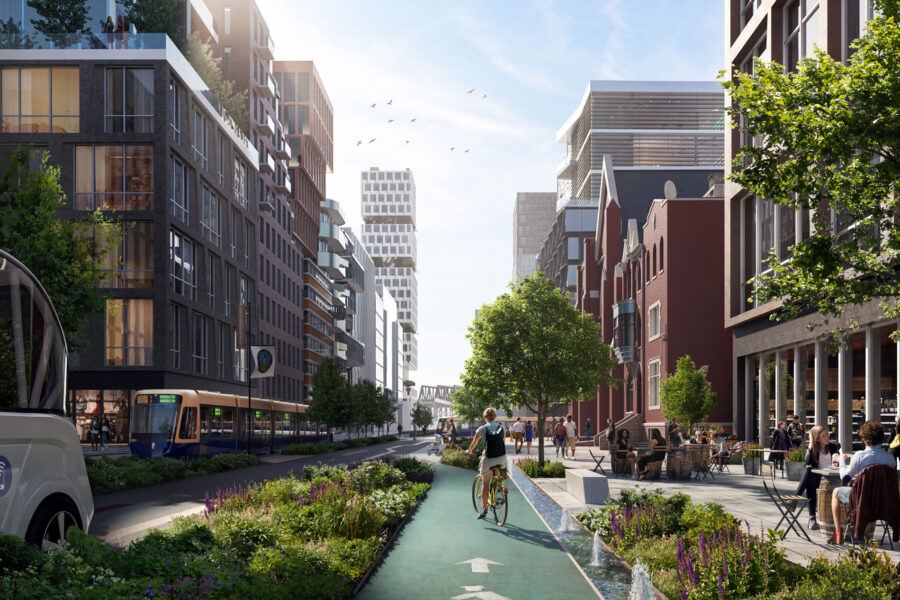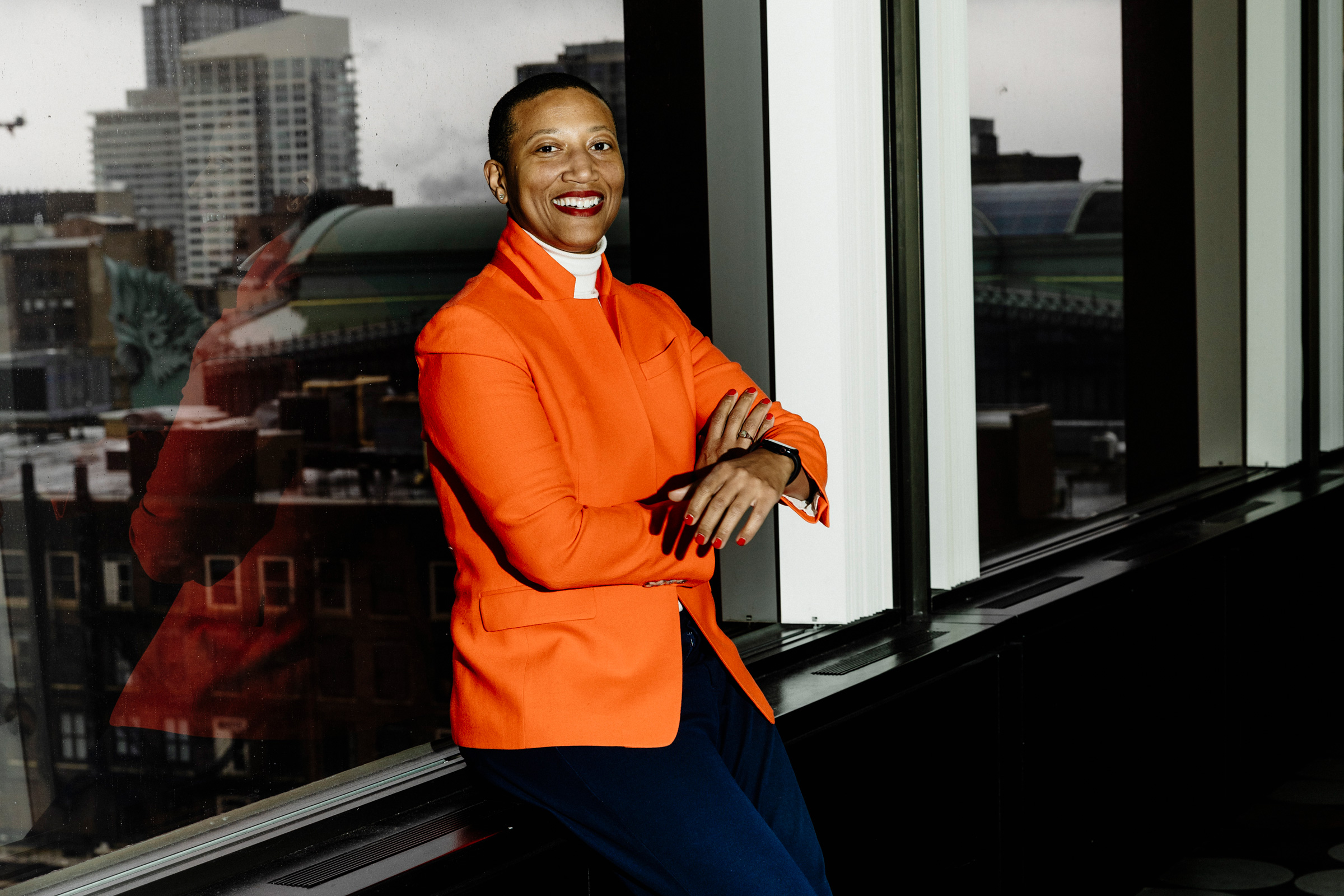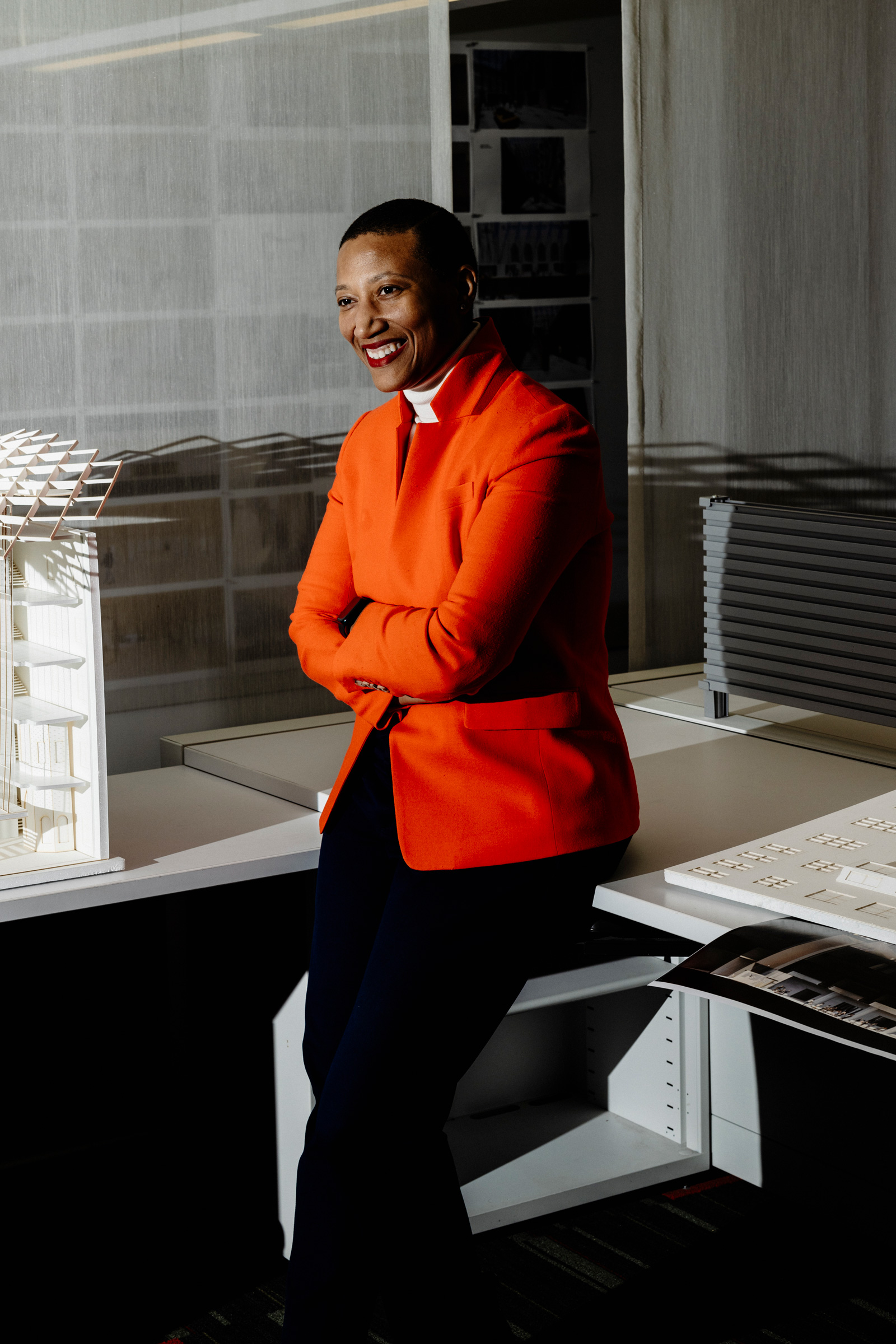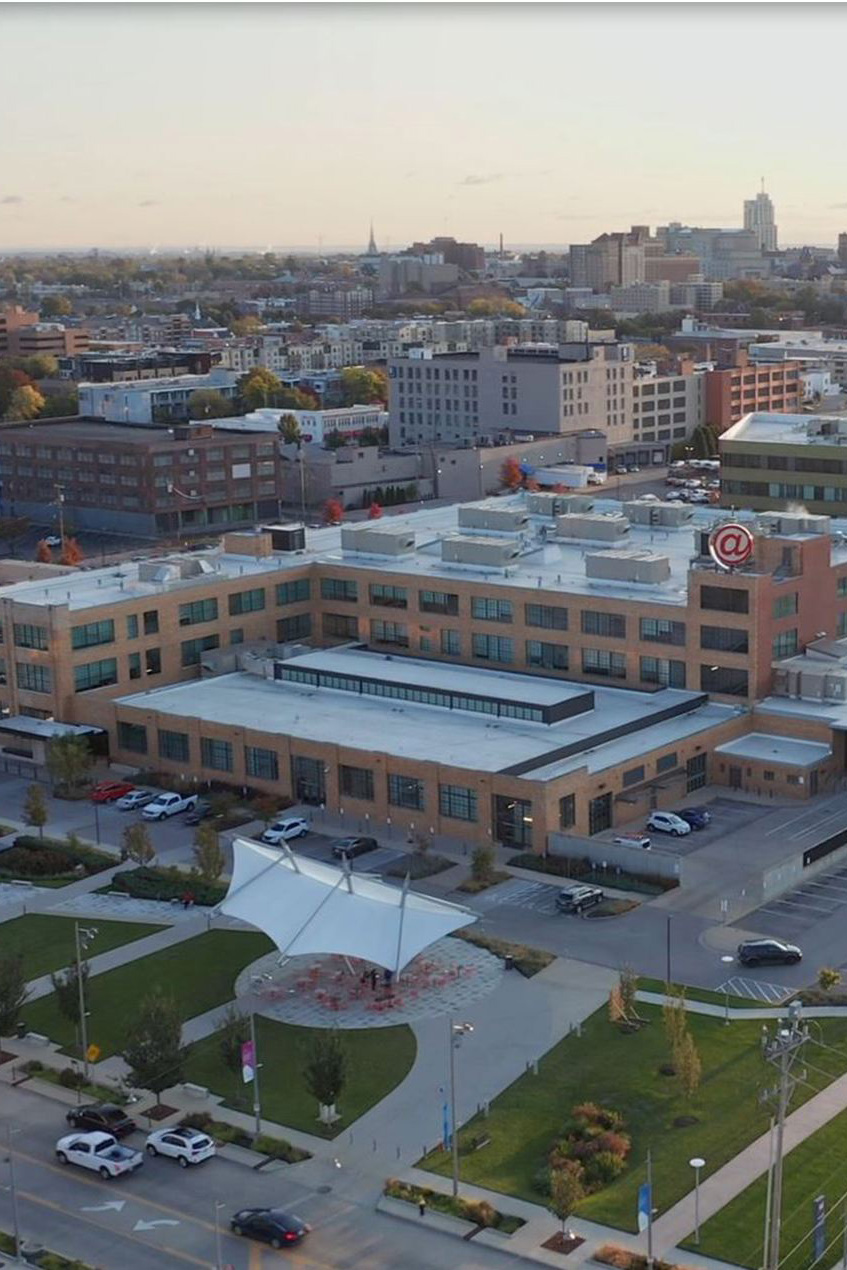Story at a glance:
- HOK’s Kimberly Dowdell, 2024 president of the AIA, is one of the top architects designing for equity.
- She wants people to understand why architecture matters and to really think about the buildings they inhabit and why good design matters.
- “As architects we shape the way people live, work and play. We have a pretty major responsibility when it comes to climate action, and we need to do better.”
She doesn’t like to say it, but technically it’s true. She’s been a leader for more than 30 years. She laughs because, well, she’s 40. But even as a kid her peers turned to her when someone needed to step up. They’d say, “Kim, you should be the leader.”
“My first presidency was when I was 7. I was president of the Youth Usher Board at my church.” Big changes were made almost immediately. “I didn’t like the uniforms,” she laughs. “I worked closely with my grandmother and others to get that done. It was an early win to prove they made the right decision.”
But in all seriousness, Kimberly Dowdell has been making tremendous strides in an effort to make the world a better place since the start of her career or earlier. Today she serves as president of the American Institute of Architects (AIA) while continuing her busy role as the director of strategic relationships at HOK, a global design firm. She’s also past president of the National Organization of Minority Architects (NOMA)—essentially a six year-commitment that ended in 2022.
- In spring 2024 Kimberly Dowdell was traveling much of the time as part of her many AIA and other speaking engagements. Photo by Chris Howe
- The Cortex Innovation Center in St. Louis is a recent example of adaptive reuse by HOK that Dowdell is proud of. The former industrial district is now the Center of Research Technology and Entrepreneurial Exchange. Photo courtesy of HOK
She remembers when her mentor suggested the NOMA role, driving from Chicago to meet her in Detroit (she splits time between the two cities as much as possible) to float the idea at a restaurant. “We order our food, and he’s like, ‘Kim, it’s time for you to be NOMA’s president.’” She was taken aback. She was 33 at the time, but she’d been involved with the organization since she was a student, including working as a university liaison.
It was a fulfilling experience, though challenging. She was considering taking a break from such active leadership roles when then she got a call from a past AIA president with a similar message—that she should run for president.
“I was so exhausted from these past six years, part of which was the pandemic, but I was really proud of the work I did with NOMA. We nearly tripled our membership from 900 to nearly 3,000 in a two-year window and created or enhanced a lot of impactful programs. We raised over $1 million to fund our programs and hire full-time staff for the first time. Because of the momentum that had been built with NOMA, I felt some level of confidence that I could be successful in the AIA election and continue some of the efforts I began with NOMA, specifically around racial, ethnic, and gender equity. Granted, AIA is a much larger organization, but I still felt like I had something unique to contribute there.”
Today she serves as AIA’s first Black, woman president and the organization’s 100th elected leader; it’s a one-year team she hopes shows movement to a more inclusive and equitable profession. “AIA was founded in 1857, and we know that probably wasn’t a great year to be a Black person, or a woman, and certainly not a Black woman,” she says. “We are hoping to secure a stronger future for everyone in the profession of architecture, no matter what they look like.”
More Money, More Members, More Mission
Dowdell’s mantra for her AIA presidency has been “more in ’24” and is divided into three pillars—more money, more members, more mission.
“I want architects to make more money because we provide a tremendous amount of value that isn’t necessarily seen,” she says. Architects often come out of school with debt, while starting salaries tend to be in the $50 to $60,000 range.
“Because of that we lose a lot of young talent,” Dowdell says. “We’re really trying to think about talent, attraction, and retention. We have to make sure young people are seeing this as a viable profession. It is very rewarding in a lot of ways, but we have to make sure the financial piece is there. If we want to have a more equitable profession, we also have to make sure you’re not just coming from a background of privilege.”
If we want to have a more equitable profession, we also have to make sure you’re not just coming from a background of privilege.
It takes many in the profession five to seven years of education to pursue licensure. On average it is reported to take more than 13 years to become a licensed architect, factoring in education, required work experience, and examinations. That’s a lot of time that could be spent making money in other roles, for example, like working for construction companies or as project managers in an engineering company. “Almost all the other companies in the built environment are more profitable,” she says.
Dowdell says she is lucky to come from very humble beginnings in Detroit because it allowed her to get a lot of scholarships. “I was a smart, articulate little kid who was like, ‘I want to be an architect to save the world.’” Between scholarships, financial aid, and church assistance, she came out of school with no loans. “But I also started out with $0,” she says.
The middle class doesn’t have the same support, she says, in terms of scholarship and financial assistance, as many people expect them to be able to “pay something” and “figure it out.” And school today is even more expensive, from tuition to supplies to the simple cost of living. “You have to come from a background of privilege or be very lucky. Most people are not in that spot,” she says.
Inspiring Architects

HOK is also committed to designing transit projects for equity, like this rendering showing 9th Street in Brooklyn. Rendering courtesy of HOK
Until about age 11 Dowdell thought she wanted to be a doctor when she grew up. She had a change of heart when, as a kid in the ’90s in Detroit, she was fascinated by the old Hudson’s department store downtown. “It closed the year I was born.” The place where her family used to go for photos with Santa sat empty. “It took up a full city block, but when I experienced it—never on the inside—it was psychologically draining.”
At the time Detroit was experiencing a lot of disinvestment as people moved out of the city and more buildings became vacant, leading to more crime and just an overall not great situation, she says. “In a middle school art class I learned about what an architect did, and I somehow made this connection between architecture, buildings, and the health of the city,” she recalls. The 11-year-old Dowdell thought, “If I become an architect I can fix this building, and then that could heal the community.”
While she grew up to learn that’s not quite how things work, it also contributed to her love of green building and adaptive reuse. “The most sustainable building is the one that already exists,” she says. Sadly that building from her childhood was demolished, but the site will soon be home to Hudson’s Detroit—a 1.5-million-square-foot mixed-use development that is expected to house offices, retail, a hotel, rooftop bar, condos, and more. General Motors recently named the site as its new global headquarters. The project is designed by SHoP with many local design contributors.
One of Dowdell’s earliest successes was the SEED Network, an idea she and fellow architects, designers, and leaders developed in 2005. Dowdell created the initial idea while sitting at her desk at the US General Services Administration in the Office of the Chief Architect, where she was an intern. Her supervisor and mentor Steve Lewis soon shared the idea at a program hosted by Harvard Graduate School of Design, which resulted in a larger movement toward a network of like-minded professionals. “LEED was becoming popular, and I was like, ‘That’s great, but we need something for the social issues.’” The community-based design network has a mission to advance the right of every person to live in a socially, economically, and environmentally healthy community.
Considering the impact on people as part of every project is part of the HOK ethos. “We design the places that make cities work,” Dowdell says, echoing Peter Ruggiero, design principal for HOK’s Chicago studio. “We’re probably most known for our sports stadiums and airports, and those are part of the inner workings of the city, but we’re also preserving existing buildings. Our work is driven by what our clients ask us to do, but we’re excited to really support the mission of our clients in service to the broader communities we serve.”
One reason she joined HOK initially, back in 2008 when she worked in their New York office, was because it felt like a place where she could grow. “I really appreciated their approach to sustainable design, which at that point wasn’t yet a buzzword. I have on my bookshelf the HOK Guidebook to Sustainable Design, published in 2000. That signaled to me that the firm was doing things that maybe other firms were not.”
Architects are the civic problem solvers, but we’re not often utilized in that way.
But in thinking about designing for equity, it’s not just about what a project gives a person or community, but it’s also considering what might be lost. “You have to find ways to minimize those impacts, and you have to have conversations to understand what those potentially negative impacts are,” Dowdell says. “A big component of design for equity is actually listening to the communities that are impacted by work and really taking stakeholder engagement seriously, thinking critically about who those stakeholders are, and how this project, whatever size or scale it is, impacts their work, their lives, how they play, their health outcomes, everything. That’s important.”
With the year flying by, Dowdell zeroed in early on what she hoped would be part of her legacy at AIA. It’s called the Chief Architect Initiative, or the idea of cities having chief architects.
“Architects are the civic problem solvers. We have all of this high-level training and technical expertise and the ability to leverage design thinking to solve complex problems, but we’re not often utilized in that way,” she says. “Let’s think about the city as a client. Having a chief architect in place to be a key advisor to mayors on issues around climate action, affordable housing, adaptive reuse, or blight—these are some of the things many cities deal with that having that unique perspective to weigh in on could be really valuable.”
She envisions a network of architects that not only support their individual cities but also work together to compare what they’re seeing and share resources. “I’d love to find a philanthropic source to fund and maybe pilot a few cities to fund a chief architect for a number of years. I think that would be a huge success.”






